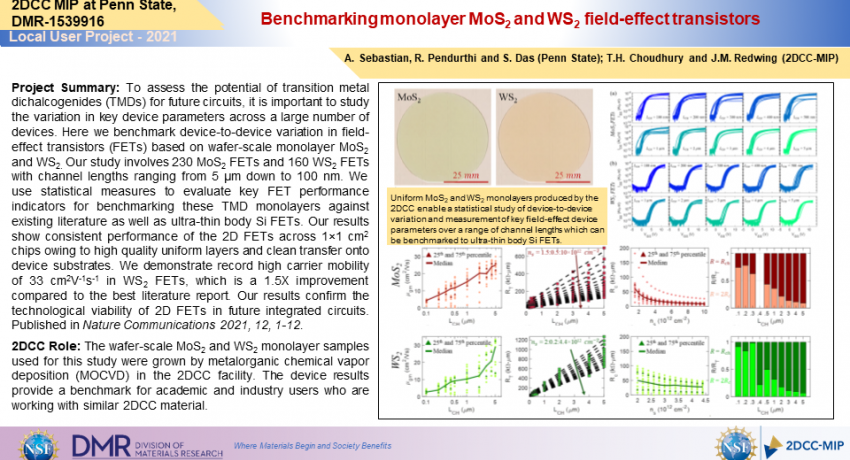What Has Been Achieved:
We have carried out a comprehensive statistical analysis of device-to-device variation of key device parameters of monolayer MoS2 and WS2 FETs related to ON-state and OFF-state performance such as threshold voltage, subthreshold slope, field effect mobility, contact resistance, etc. The results are benchmarked against literature reports of TMD FETs and ultra-thin body silicon-on-insulator FETs.
Importance of the Achievement:
Field-effect transistors based on monolayer MoS2 and WS2 are receiving increasing attention owing to their ultra-thin body nature that can mitigate detrimental short-channel effects in aggressively scaled devices through improved electrostatics enabling them to replace or complement Si technology. To assess the potential of these devices for future circuits, it is important to study the variation in key device parameters that determine the ON-state and OFF-state performance across a large number of devices. Unfortunately, given the limited availability of large area TMD monolayers, there are only a few studies that report device-to-device variation in MoS2 FETs and none for WS2 FETs. This work demonstrates that 2D FETs based on monolayer TMDs are promising alternatives for future very-large-scale-integration (VLSI) circuits.
Unique Feature(s) of the MIP that Enabled this Achievement:
This study was enabled by the availability of high quality, uniform wafer-scale monolayer epitaxial MoS2 and WS2 films produced in the 2CC facility.
Publication:
Amritanand Sebastian, Rahul Pendurthi, Tanushree H. Choudhury, Joan M. Redwing and Saptarshi Das, “Benchmarking monolayer MoS2 and WS2 field-effect transistors,” Nature Communications 2021, 12, pp. 1-12. https://doi.org/10.1038/s41467-020-20732-w
Acknowledgments:
The work was partially supported by Army Research Office (ARO) through Contract Number W911NF1920338. Authors also acknowledge the support from the National Science Foundation (NSF) through the Pennsylvania State University 2D Crystal Consortium–Materials Innovation Platform (2DCCMIP) under NSF cooperative agreement DMR-1539916.
Credits/Names: A. Sebastian, R. Pendurthi and S. Das (Penn State); T.H. Choudhury and J.M. Redwing (2DCC-MIP)
Download PDF Version: 1539916_2DCCMIP_2021_BenchmarkingMonolayerMoS2andWS2Field-EffectTransistors.pdf
Year of Research Highlight: 2021
Select a Highlight Type: User Highlight
